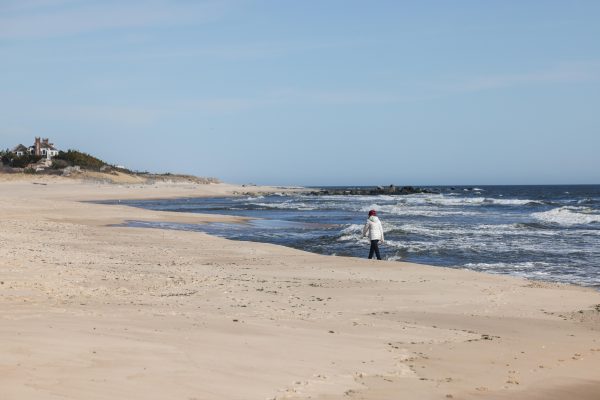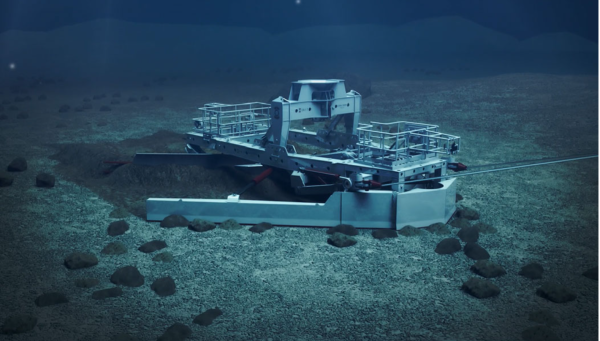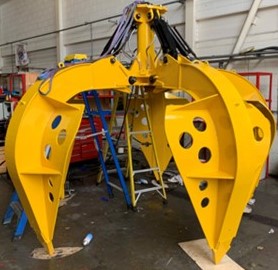| Wind Watch is a registered educational charity, founded in 2005. |
Undersea plow to clear wide swath for South Fork wind farm cable
Credit: By Mark Harrington | October 3, 2022 | newsday.com ~~
The developers of the South Fork Wind Farm have begun preparing the long undersea cable route to Long Island through use of sea-bottom boulder plow that will clear a 52-foot wide swath of the ocean floor, rankling fishermen concerned about impacts on the environment and lost wages.
The plowing “may occur perpendicular to Long Island” at a minimum distance of 4 miles, said Meaghan Wims, a spokeswoman for the South Fork Wind Farm, which is being developed by Denmark-based Orsted and New England-based Eversource.

Wainscott Beach in Wainscott, where offshore wind power form the South Fork Wind Farm will come ashore once completed, is seen on Friday, Feb. 11, 2022. Credit: Newsday/Steve Pfost
Wims said the plow will only be used in federal water, not within the three-mile limit of state waters, though the vessel will track east parallel to the Hamptons’ coast. A separate vessel will use a crane-like pick to lift large boulders from the sea bed.
The plow will clear up to 40 miles along the cable route, Wims said, and up to another 9 miles of sea bottom around the turbine arrays off the Rhode Island/Massachusetts coast, she said.
“The plow is used to displace boulders to the side, creating a corridor for cable installation that is approximately 52-feet wide,” South Fork said in a statement to Newsday. “Subsurface boulders within the top five feet will also be displaced to the side of the corridor. The plow pushes aside boulders in its path at a rate of less than a quarter mile per hour.”
A warning issued by Orsted to fishermen says the plow will be towed at 0.25 knots, attached via a 300 yard cable to a vessel that “will not be able to deviate from its route once the plow is deployed. Fishing gear in these corridors risk being damaged by the plow and close coordination is vital.”
But as the work starts, fishermen have been expressing concern not only about damage to the sea floor, including in areas where lobstermen fish, but lost wages when they are restricted from the areas.
“They’re destroying bottom that people have fished on forever,” said Vinny Damm, a longtime lobsterman from Montauk. “I just don’t understand how they [regulators] are allowing it to happen.”
Wims said the damage to living fish would be small.
“Due to the extremely slow movement of the plow, mobile finfish and crustations are expected to avoid interaction with the plow,” she said. South Fork Wind said it “anticipates” that shellfish and fauna will “recolonize” after construction is complete.
Asked how long it would take the bottom to recolonize, Wims declined to say.
Anthony Sosinski, another Montauk lobster and crab fisherman, said he’s concerned about the long-term impact of both the plowing and the high-voltage cable, particularly about potential effects on fish behavior through electromagnetic fields.
“Who knows what the impact will be,” he said. “I’m not concerned the stuff grow back. I’m concerned about and electric line glowing and the impact on fish that migrate around it.”
An analysis of the work conducted by the state of Rhode Island’s Coastal Resources Management Council found the installation of submarine cables for the South Fork Wind project “will result in benthic habitat disturbance through the process of relocating boulders, plowing trenches for the cables and then burying them with new sediment; subsequent repairs and modification of these cables would create additional habitat disturbance.”
The council said the federal Bureau of Ocean Energy Management indicated in its draft environmental impact statement for the project that it anticipates 179.3 acres of “long-term disturbance to benthic habitat along the export cable route.”
The disturbances, the council said, include sediment disturbance, turbidity, construction-related underwater noise, and conversion to new habitat types, and are “most problematic for sessile benthic organisms,” which include fish, crabs, shrimp, snails, urchins, sea stars, and slugs, as well as less mobile animals such as barnacles, sponges, oysters, mussels and corals.”
The council noted the cable “may also emit electromagnetic fields, which may have some effects on some fish species, especially sharks, rays, and bony fishes.”
Damm said many lobsters in the area are molting and less likely to move out of the range of the plow. “They hide in the rocks, and they are going to get mowed.”
Damm said he’s been given coordinates to keep his gear out of areas that will be plowed, but said he believes fishermen should be compensated for it.
Bonnie Brady, executive director of the Long Island Commercial Fishing Association, said that’s not happening because New York, unlike other coastal states impacted by wind farm development activity, did not receive a “federal consistency review over the project” and thus New York fishermen aren’t eligible for compensation for work done in federal waters. It’s unfortunate, she said, because New York fishing interests are “the most affected by the entire cable.”
This article is the work of the source indicated. Any opinions expressed in it are not necessarily those of National Wind Watch.
The copyright of this article resides with the author or publisher indicated. As part of its noncommercial educational effort to present the environmental, social, scientific, and economic issues of large-scale wind power development to a global audience seeking such information, National Wind Watch endeavors to observe “fair use” as provided for in section 107 of U.S. Copyright Law and similar “fair dealing” provisions of the copyright laws of other nations. Send requests to excerpt, general inquiries, and comments via e-mail.
| Wind Watch relies entirely on User Contributions |
 (via Stripe) |
 (via Paypal) |
Share:



